In Situ Nondestructive Detection of Nitrogen Content in Soybean Leaves Based on Hyperspectral Imaging Technology
Abstract
1. Introduction
2. Materials and Methods
2.1. Experimental Materials
2.2. Hyperspectral Imaging Data Acquisition
2.3. Determination and Data Division of Nitrogen Content in Soybean Leaves
2.4. Spectral Preprocessing
2.5. Selection Method of Characteristic Wavelengths
2.6. Model Construction and Evaluation
3. Results
3.1. Hyperspectral Image Extraction of Soybean Leaves
3.2. Analysis of Spectral Reflectance of Soybean Leaves
3.3. Correlation Analysis between Spectral Reflectance and Leaf Nitrogen Content of Soybean Leaves
3.4. Results of Full Spectral Models
3.5. Selection of Characteristic Wavelength of Soybean Leaf Nitrogen Content
3.6. Results of Full Spectral Models
3.7. Visualization of Nitrogen Content Distribution in Soybean Leaves
4. Discussion
5. Conclusions
- (1)
- The correlation between the spectral reflectance of soybean leaves and the leaf nitrogen content was analyzed. It was found that the correlation coefficient between soybean leaf spectral reflectance and leaf nitrogen content in the range of 798.8~1000 nm reached a very significant positive correlation level (p < 0.01), and the spectral reflectance of soybean leaves in the range of 516~615 nm and 698~774 nm was significantly negatively correlated with the leaf nitrogen content (p < 0.01). Among them, the maximum positive correlation coefficient was 0.2496 at 985 nm, and the maximum absolute value of the negative correlation coefficient of spectral reflectance was 0.4185 at 540.5 nm.
- (2)
- The performances of seven spectral preprocessing methods on the prediction of the nitrogen content in soybean leaves were compared. The PLS model combined with spectra preprocessed by DOSC had the best performance among the full-spectra models, and its Rc2 was 0.9233, RMSEC was 2.4286, Rp2 was 0.9428, RMSEP was 2.4858, and RPD was 4.2092. Therefore, the DOSC preprocessing method was selected as the best preprocessing method for the detection of the nitrogen content in soybean leaves.
- (3)
- SPA, GA and RF algorithms were employed to select the characteristic wavelengths, which were closely related to the nitrogen content in soybean leaves. The five characteristic wavelengths, including 827.262 nm, 828.844 nm, 969.166 nm, 969.959 nm and 970.752 nm selected by the RF algorithm had the best prediction effect for the prediction of the nitrogen content in soybean leaves combined with the PLS model, and its Rp2, RMSEP and RPD were 0.9261, 2.4034 and 4.3536, respectively. The selection of characteristic wavelengths not only compressed the spectral data, but also improved the prediction effect of the model. This was helpful for the development of portable detection equipment for the soybean leaf nitrogen content.
- (4)
- The visual distribution map of the nitrogen content in soybean leaves was generated using the DOSC-RF-PLS model, which was considered to be the optimal prediction model for the nitrogen content in soybean leaves. The map provided the basis for analyzing the spatial distribution difference of the nitrogen content in soybean leaves. The overall results in this study showed that hyperspectral imaging technology was an effective tool for soybean leaf nitrogen content detection and spatial distribution analysis, and provided decision-making basis for the effective monitoring of soybean nutrition and fertilization management.
Author Contributions
Funding
Data Availability Statement
Acknowledgments
Conflicts of Interest
References
- Savary, S.; Willocquet, L.; Pethybridge, S.J.; Esker, P.; McRoberts, N.; Nelson, A. The global burden of pathogens and pests on major food crops. Nat. Ecol. Evol. 2019, 3, 430–439. [Google Scholar] [CrossRef] [PubMed]
- Bureau of Statistics of the China. China Statistical Yearbook; China Statistics Press: Beijing, China, 2022. [Google Scholar]
- Zhang, Y.K.; Luo, B.; Pan, D.Y.; Song, P.; Lu, W.C.; Wang, C.; Zhao, C.J. Estimation of Canopy Nitrogen Content of Soybean Crops Based on Fractional Differential Algorithm. Spectrosc. Spectr. Anal. 2018, 38, 3221–3230. [Google Scholar]
- Pandey, P.; Payn, K.G.; Lu, Y.; Heine, A.J.; Walker, T.D.; Acosta, J.J.; Young, S. Hyperspectral imaging combined with machine learning for the detection of fusiform rust disease incidence in loblolly pine seedlings. Remote Sens. 2021, 13, 3595. [Google Scholar] [CrossRef]
- Ren, Y.; Sun, D. Monitoring of moisture contents and rehydration rates of microwave vacuum and hot air dehy-drated beef slices and splits using hyperspectral imaging. Food Chem. 2022, 382, 132346. [Google Scholar] [CrossRef] [PubMed]
- Mishra, P.; Asaari, M.S.M.; Herrero-Langreo, A.; Lohumi, S.; Diezma, B.; Scheunders, P. Close range hyperspectral imaging of plants: A review. Biosyst. Eng. 2017, 164, 49–67. [Google Scholar] [CrossRef]
- Gowen, A.; Odonnell, C.; Cullen, P.; Downey, G.; Frias, J. Hyperspectral imaging—An emerging process analytical tool for food quality and safety control. Trends Food Sci. Technol. 2007, 18, 590–598. [Google Scholar] [CrossRef]
- Zhu, H.C.; Liu, H.Y.; Xu, Y.X.; Guijun, Y. UAV-based hyperspectral analysis and spectral indices constructing for quantitatively monitoring leaf nitrogen content of winter wheat. Appl. Opt. 2018, 57, 7722–7732. [Google Scholar] [CrossRef] [PubMed]
- Goel, P.; Prasher, S.; Landry, J.; Patel, R.; Bonnell, R.; Viau, A.; Miller, J. Potential of airborne hyperspectral remote sensing to detect nitrogen deficiency and weed infestation in corn. Comput. Electron. Agric. 2003, 38, 99–124. [Google Scholar] [CrossRef]
- Zhang, X.L.; Liu, F.; Nie, P.C.; He, Y.; Bao, Y.D. Rapid detection of nitrogen content and distribution in oilseed rape leaves based on hyperspectral imaging. Spectrosc. Spectr. Anal. 2014, 34, 2513. [Google Scholar]
- Zou, X.; Shi, J.; Hao, L.; Zhao, J.; Mao, H.; Chen, Z.; Li, Y.; Holmes, M. In vivo, noninvasive detection of chlorophyll distribution in cucumber (Cucumis sativus) leaves by indices based on hyperspectral imaging. Anal. Chim. Acta 2011, 706, 105–112. [Google Scholar]
- Wang, H.; Peng, J.; Xie, C.; Bao, Y.; He, Y. Fruit Quality Evaluation Using Spectroscopy Technology: A Review. Sensors 2015, 15, 11889–11927. [Google Scholar] [CrossRef] [PubMed]
- Pu, H.B.; Kamruzzaman, M.; Sun, D.W. Selection of feature wavelengths for developing multispectral imaging systems for quality, safety and authenticity of muscle foods—A review. Trends Food Sci. Technol. 2015, 45, 86–104. [Google Scholar] [CrossRef]
- Li, X.; Jiang, H.; Jiang, X.; Shi, M. Identification of Geographical Origin of Chinese Chestnuts Using Hyperspectral Imaging with 1D-CNN Algorithm. Agriculture 2021, 11, 1274. [Google Scholar] [CrossRef]
- Nagasubramanian, K.; Jones, S.; Sarkar, S.; Singh, A.K.; Singh, A.; Ganapathysubramanian, B. Hyperspectral band selection using genetic algorithm and support vector machines for early identification of charcoal rot disease in soybean stems. Plant Methods 2018, 14, 86. [Google Scholar] [CrossRef] [PubMed]
- Eusuff, M.M.; Lansey, K.E.; Lansey, K. Optimization of Water Distribution Network Design Using the Shuffled Frog Leaping Algorithm. J. Water Resour. Plan. Manag. 2003, 129, 210–225. [Google Scholar] [CrossRef]
- Orrillo, I.; Cruz-Tirado, J.P.; Cardenas, A.; Oruna, M.; Carnero, A.; Barbin, D.F.; Siche, R. Hyper-spectral imaging as a powerful tool for identification of papaya seeds in black pepper. Food Control 2019, 101, 45–52. [Google Scholar] [CrossRef]
- Kamruzzaman, M.; Elmasry, G.; Sun, D.W.; Allen, P. Prediction of some quality attributes of lamb meat using near-infrared hy-perspectral imaging and multivariate analysis. Anal. Chim. Acta 2012, 714, 57–67. [Google Scholar] [CrossRef]
- Gao, Z.; Luo, N.; Yang, B.; Zhu, Y. Estimating Leaf Nitrogen Content in Wheat Using Multimodal Features Extracted from Canopy Spectra. Agronomy 2022, 12, 1915. [Google Scholar] [CrossRef]
- Kjær, A.; Nielsen, G.; Stærke, S.; Clausen, M.R.; Edelenbos, M.; Jørgensen, B. Prediction of Starch, Soluble Sugars and Amino Acids in Potatoes (Solanum tuberosum L.) Using Hyperspectral Imaging, Dielectric and LF-NMR Methodologies. Potato Res. 2016, 59, 357–374. [Google Scholar] [CrossRef]
- Rady, A.; Guyer, D. Evaluation of sugar content in potatoes using NIR reflectance and wavelength selection techniques. Postharvest Biol. Technol. 2015, 103, 17–26. [Google Scholar] [CrossRef]
- Shao, Y.Y.; Liu, Y.; Xuan, G.T.; Wang, Y.X.; Gao, Z.M.; Hu, Z.C.; Han, X.; Gao, C.; Wang, K.L. Application of hyperspectral imaging for spatial prediction of soluble solid content in sweet potato. RSC Adv. 2020, 10, 33148–33154. [Google Scholar] [CrossRef] [PubMed]
- Liu, Z.Y. Review and prospect of plant nutrition diagnosis. Soils 1990, 22, 173–176. [Google Scholar]
- Jiang, Y.M. Study on Mineral Nutrition Characteristics, Nutrition Diagnosis and Fertilization of Red Fuji Apple; China Agricultural University: Beijing, China, 2001. [Google Scholar]
- Card, D.H.; Peterson, D.L.; Matson, P.A.; Aber, J.D. Prediction of leaf chemistry by the use of visible and near infrared re-flectance spectroscopy. Remote Sens. Environ. 1988, 26, 123–147. [Google Scholar] [CrossRef]
- Turner, F.T.; Jund, M.F. Assessing the nitrogen requirements of rice crops with a chlorophyll meter. Aust. J. Exp. Agric. 1994, 34, 1001–1005. [Google Scholar] [CrossRef]
- Schepers, J.S.; Francis, D.D.; Vigil, M.; Below, F.E. Comparison of corn leaf nitrogen concentration and chlorophyll meter readings. Commun. Soil Sci. Plant Anal. 1992, 23, 2173–2187. [Google Scholar] [CrossRef]
- Kang, K.; Zhang, W.; He, Y.; Qi, L.Q.; Zhang, P. Detection of nitrogen content in soybean canopy leaves based on UAV multi-spectral images. Agric. Mech. Res. 2024, 46, 151–156. [Google Scholar]
- Wang, L.F.; Zhang, C.L.; Zhao, Y.; Song, Y.Z.; Wang, R.T.; Su, Z.B.; Wang, S.W. Detection model of nitrogen content in maize leaves by hyperspectral imaging technology. Agric. Mech. Res. 2017, 39, 140–147. [Google Scholar]
- Qin, Z.F.; Chang, Q.R.; Xie, B.N.; Shen, J. Estimation of total nitrogen content in rice leaves in Yellow River irrigation area based on UAV hyperspectral image. Acta Agric. Eng. Sci. 2016, 32, 77–85. [Google Scholar]
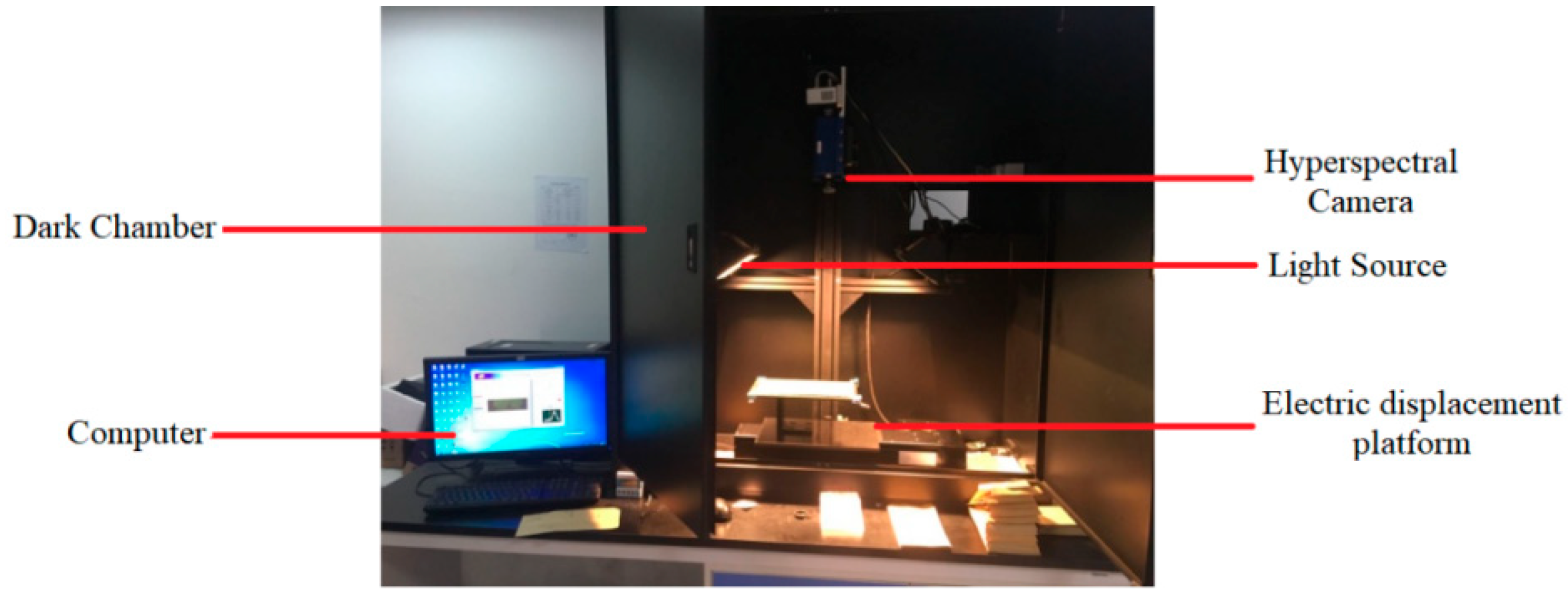

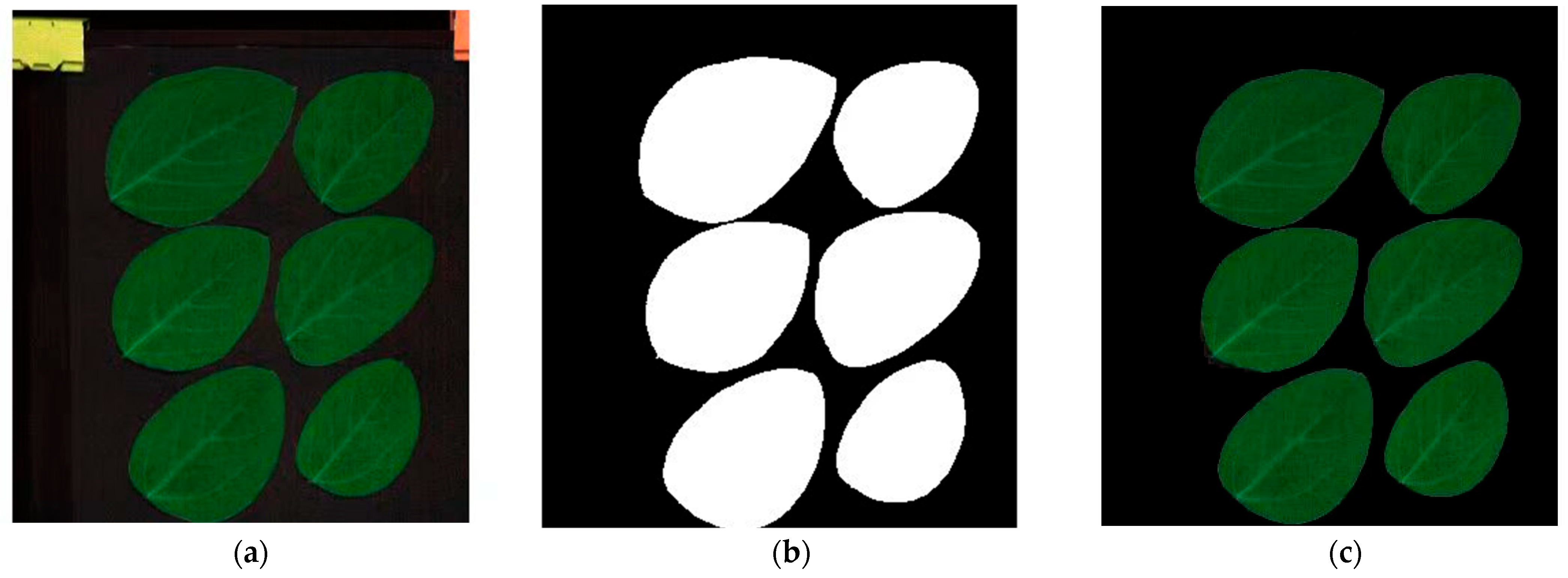
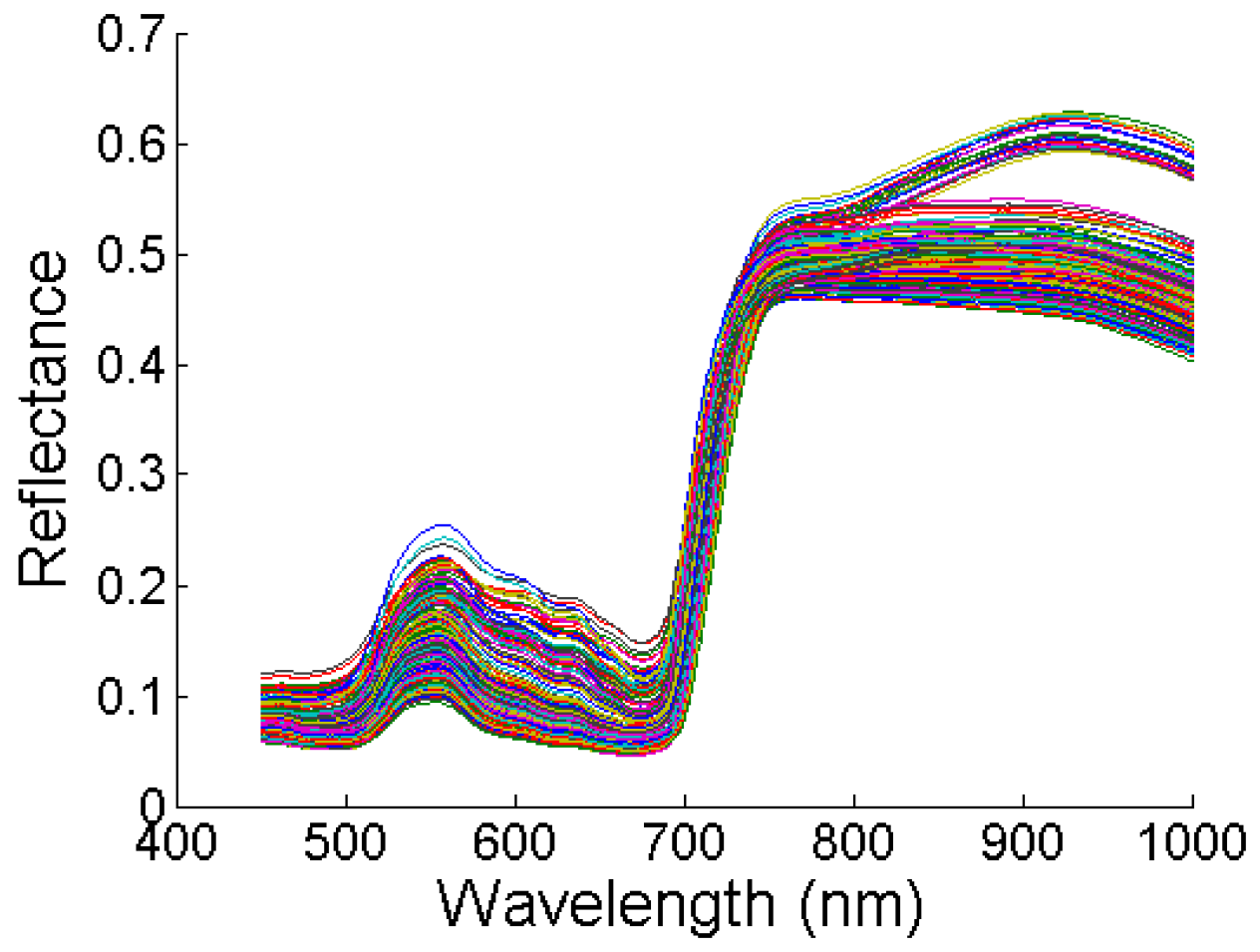
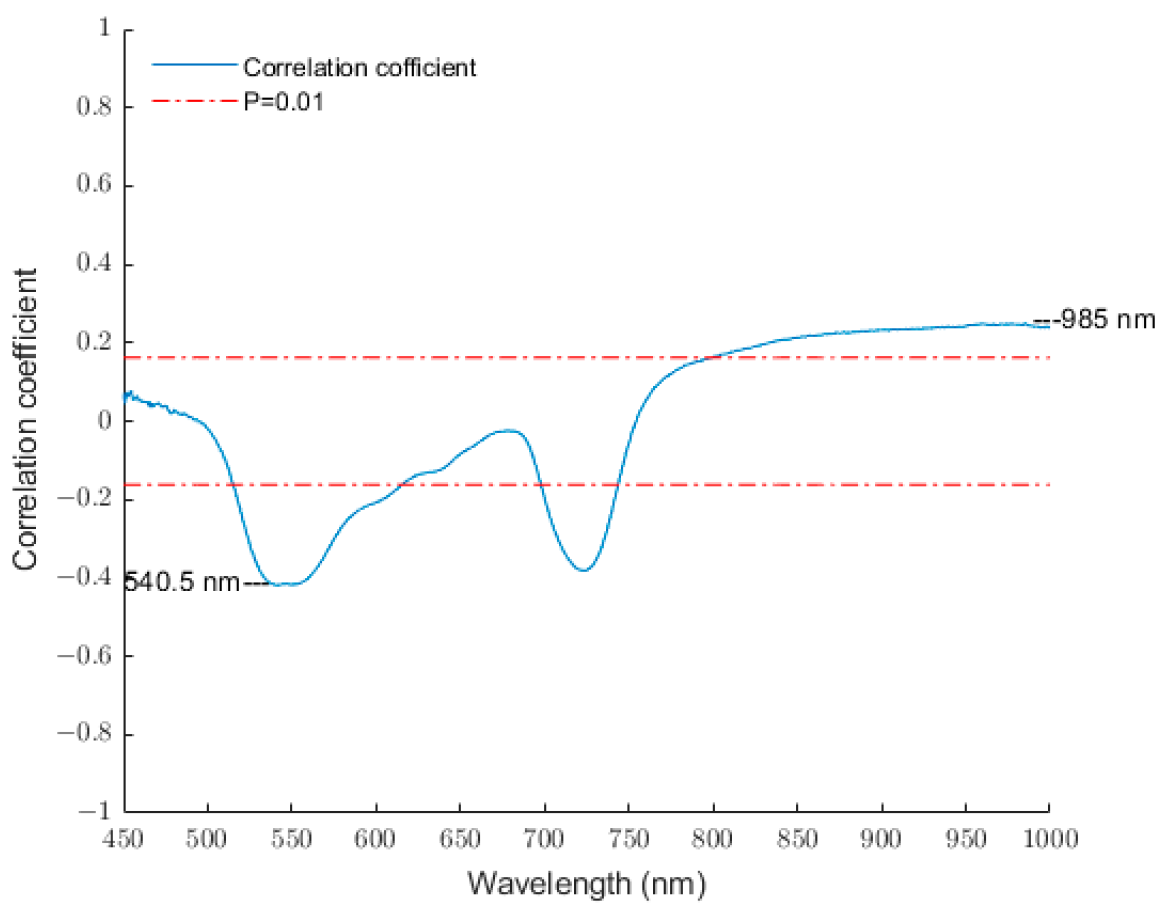
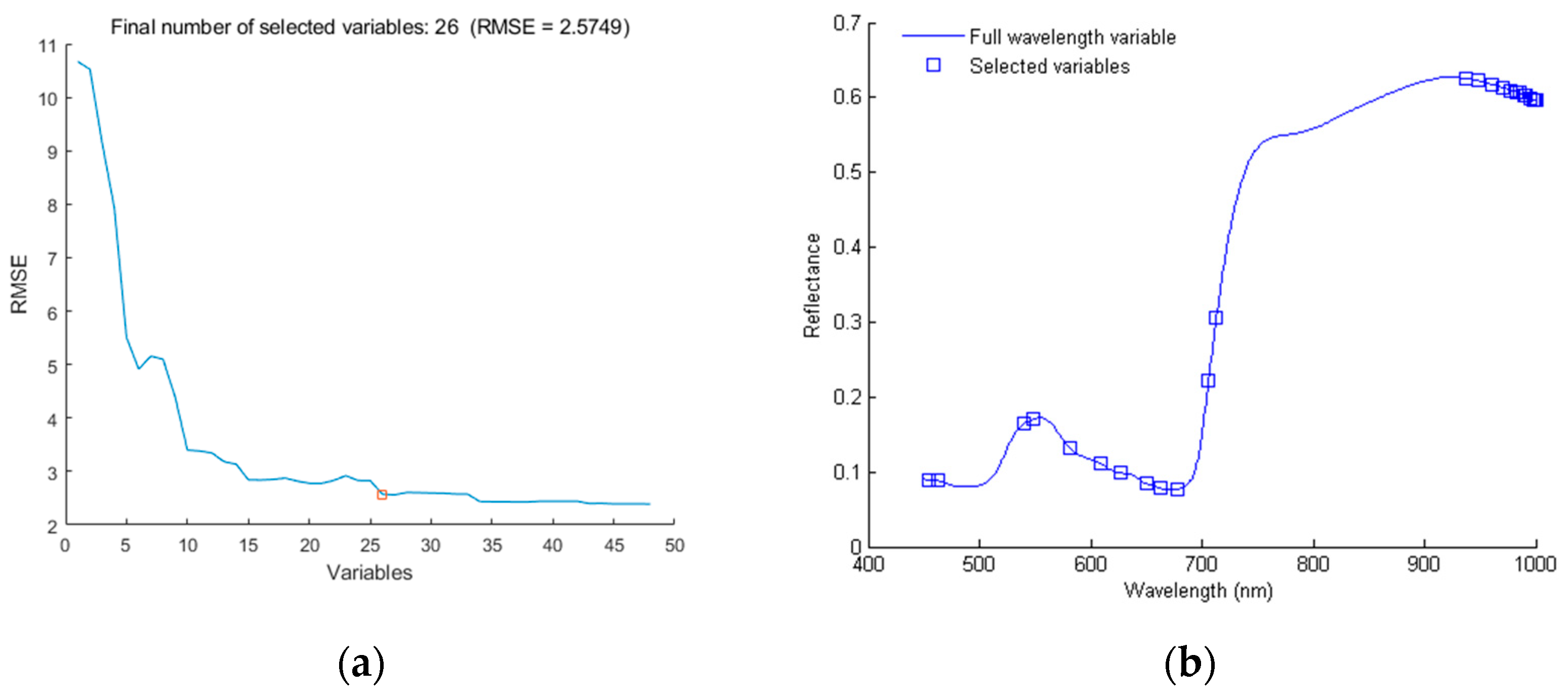
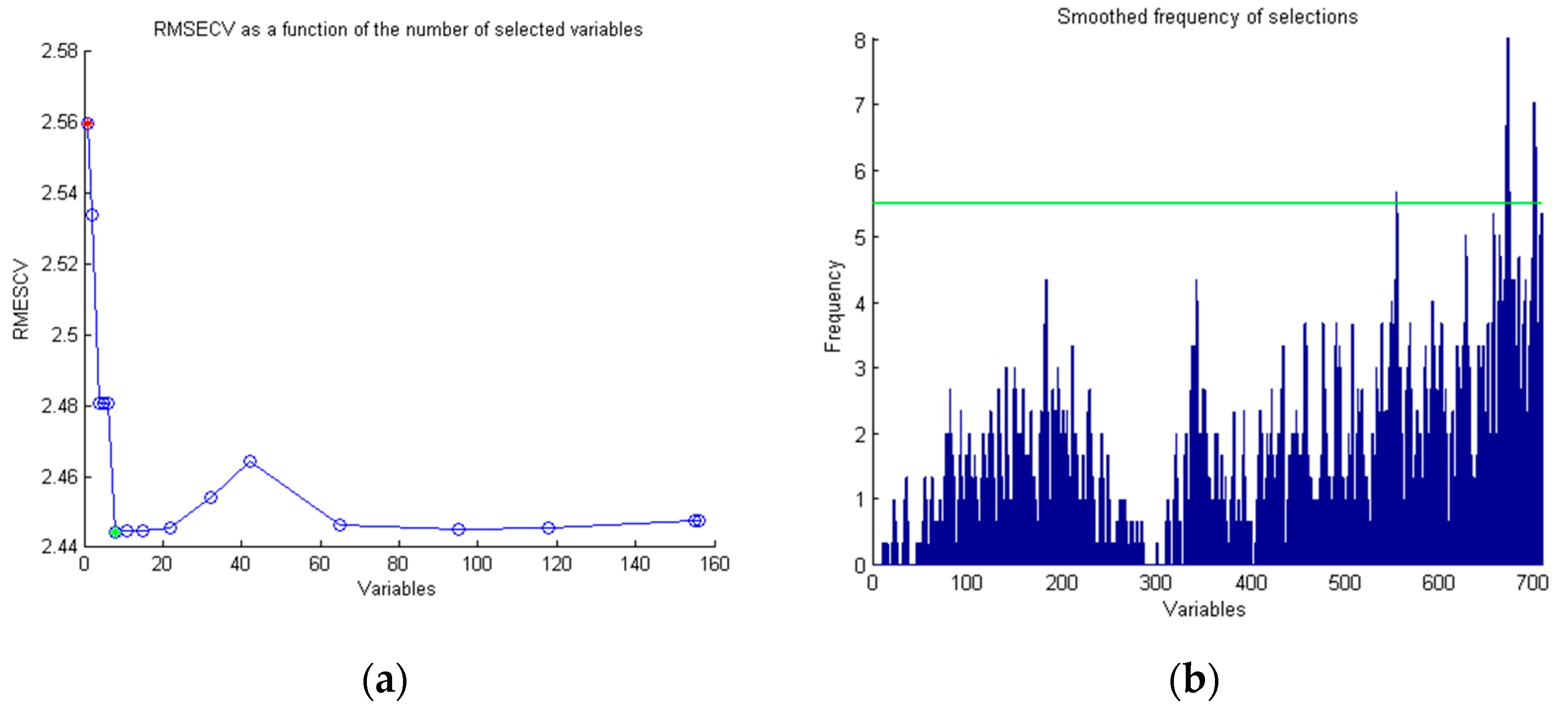

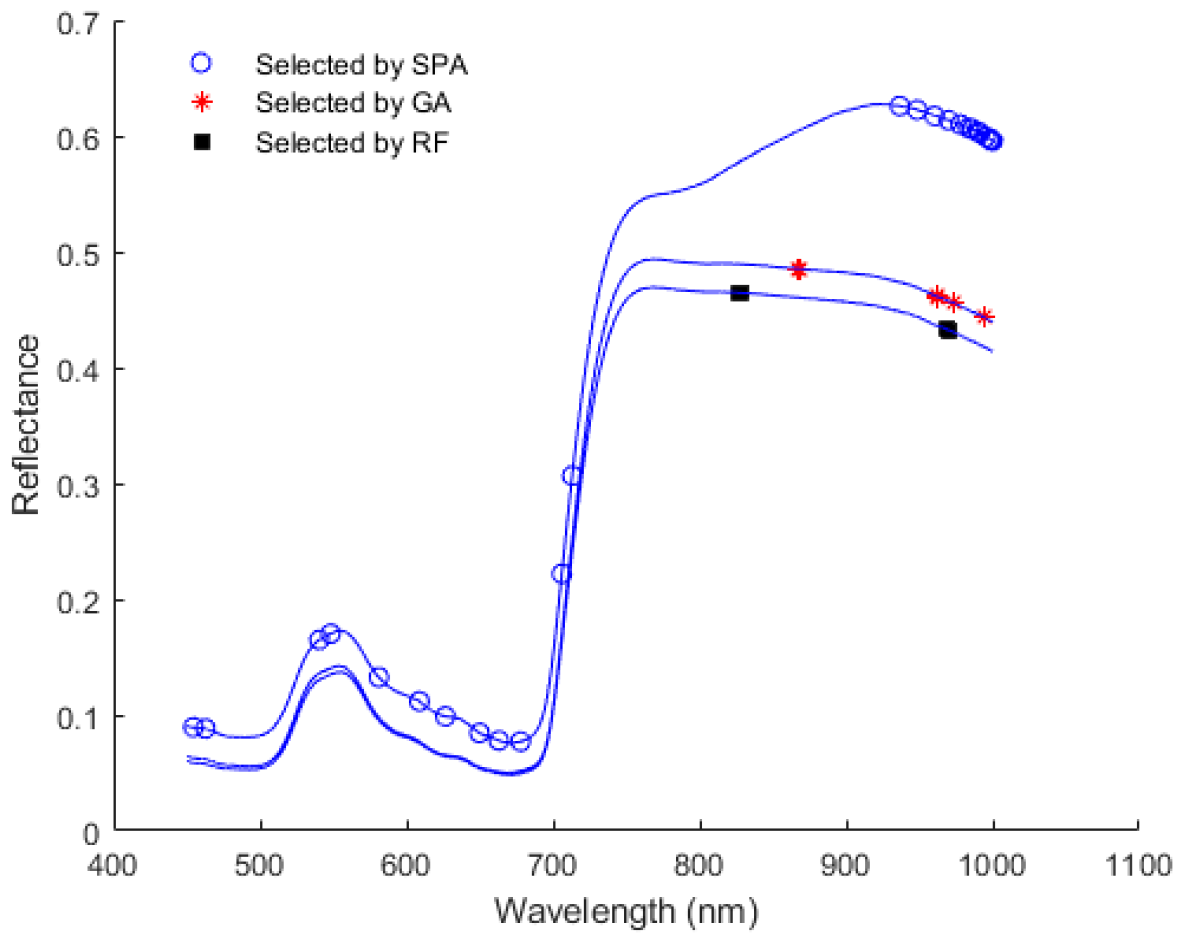


| Processing Number | z1 (N) | z2 (P) | z3 (K) | N (kg/hm2) | P (kg/hm2) | K (kg/hm2) |
|---|---|---|---|---|---|---|
| 1 | 1 | 1 | 1 | 63.80 | 100.25 | 127.59 |
| 2 | 1 | 1 | −1 | 63.80 | 100.25 | 12.41 |
| 3 | 1 | −1 | 1 | 63.80 | 9.75 | 127.59 |
| 4 | 1 | −1 | −1 | 63.80 | 9.75 | 12.41 |
| 5 | −1 | 1 | 1 | 6.20 | 100.25 | 127.59 |
| 6 | −1 | 1 | −1 | 6.20 | 100.25 | 12.41 |
| 7 | −1 | −1 | 1 | 6.20 | 9.75 | 127.59 |
| 8 | −1 | −1 | −1 | 6.20 | 9.75 | 12.41 |
| 9 | 1.21541 | 0 | 0 | 70.00 | 55.00 | 70.00 |
| 10 | −1.21541 | 0 | 0 | 0.00 | 55.00 | 70.00 |
| 11 | 0 | 1.21541 | 0 | 35.00 | 110.00 | 70.00 |
| 12 | 0 | −1.21541 | 0 | 35.00 | 0.00 | 70.00 |
| 13 | 0 | 0 | 1.21541 | 35.00 | 55.00 | 150.00 |
| 14 | 0 | 0 | −1.21541 | 35.00 | 55.00 | 0.00 |
| 15 | 0 | 0 | 0 | 35.00 | 55.00 | 70.00 |
| Sample Sets | Number | Range (mg/g) | Mean (mg/g) | SD (mg/g) | CV (100%) |
|---|---|---|---|---|---|
| Calibration set | 184 | 8.275~44.724 | 28.052 | 9.219 | 32.864 |
| Prediction set | 61 | 11.367~43.429 | 31.324 | 9.823 | 31.359 |
| Preprocessing Methods | LVs | Calibration Set | Prediction Set | |||
|---|---|---|---|---|---|---|
| Rc2 | RMSEC (mg/g) | Rp2 | RMSEP (mg/g) | RPD | ||
| RAW | 18 | 0.9187 | 2.5001 | 0.9377 | 2.5919 | 4.0370 |
| SG | 17 | 0.8916 | 2.8874 | 0.9373 | 2.5983 | 4.0269 |
| MSC | 17 | 0.9199 | 2.4814 | 0.9370 | 2.6130 | 4.0044 |
| SNV | 18 | 0.9210 | 2.4643 | 0.9365 | 2.6194 | 3.9945 |
| De-trending | 17 | 0.9239 | 2.4188 | 0.9411 | 2.5193 | 4.1532 |
| 1-Der | 11 | 0.9201 | 2.4788 | 0.9349 | 2.6475 | 3.9521 |
| 2-Der | 4 | 0.9040 | 2.7168 | 0.9263 | 2.8322 | 3.6945 |
| DOSC | 1 | 0.9233 | 2.4286 | 0.9428 | 2.4858 | 4.2092 |
| Models | EW | LVs | Calibration Set | Prediction Set | |||
|---|---|---|---|---|---|---|---|
| Rc2 | RMSEC (mg/g) | Rp2 | RMSEP (mg/g) | RPD | |||
| DOSC-PLS | 707 | 1 | 0.9233 | 2.4286 | 0.9428 | 2.4858 | 4.2092 |
| SPA-PLS | 26 | 1 | 0.9184 | 2.5047 | 0.9413 | 2.5654 | 4.0785 |
| GA-PLS | 7 | 2 | 0.9234 | 2.4278 | 0.9430 | 2.4835 | 4.2132 |
| RF-PLS | 5 | 5 | 0.9261 | 2.3834 | 0.9466 | 2.4034 | 4.3536 |
Disclaimer/Publisher’s Note: The statements, opinions and data contained in all publications are solely those of the individual author(s) and contributor(s) and not of MDPI and/or the editor(s). MDPI and/or the editor(s) disclaim responsibility for any injury to people or property resulting from any ideas, methods, instructions or products referred to in the content. |
© 2024 by the authors. Licensee MDPI, Basel, Switzerland. This article is an open access article distributed under the terms and conditions of the Creative Commons Attribution (CC BY) license (https://creativecommons.org/licenses/by/4.0/).
Share and Cite
Zhang, Y.; Guan, M.; Wang, L.; Cui, X.; Li, T.; Zhang, F. In Situ Nondestructive Detection of Nitrogen Content in Soybean Leaves Based on Hyperspectral Imaging Technology. Agronomy 2024, 14, 806. https://doi.org/10.3390/agronomy14040806
Zhang Y, Guan M, Wang L, Cui X, Li T, Zhang F. In Situ Nondestructive Detection of Nitrogen Content in Soybean Leaves Based on Hyperspectral Imaging Technology. Agronomy. 2024; 14(4):806. https://doi.org/10.3390/agronomy14040806
Chicago/Turabian StyleZhang, Yakun, Mengxin Guan, Libo Wang, Xiahua Cui, Tingting Li, and Fu Zhang. 2024. "In Situ Nondestructive Detection of Nitrogen Content in Soybean Leaves Based on Hyperspectral Imaging Technology" Agronomy 14, no. 4: 806. https://doi.org/10.3390/agronomy14040806
APA StyleZhang, Y., Guan, M., Wang, L., Cui, X., Li, T., & Zhang, F. (2024). In Situ Nondestructive Detection of Nitrogen Content in Soybean Leaves Based on Hyperspectral Imaging Technology. Agronomy, 14(4), 806. https://doi.org/10.3390/agronomy14040806






